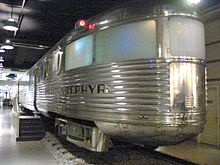Pioneer Zephyr
| Pioneer Zephyr | |
|---|---|
|
Promotional postcard: The most Illustrious Railroad Train of the World (ca.1935)
|
|
| Numbering: | 9900 |
| Number: | 1 |
| Manufacturer: | Budd |
| Year of construction (s): | 1934 |
| Retirement: | 1960 |
| Axis formula : | Bo'2'2'2 ' |
| Length over buffers: | 60 m |
| Service mass: | 80 t |
| Friction mass: | 41 t |
| Wheel set mass : | 20.5 t |
| Top speed: | 110 mph (180 km / h) |
| Traction power: | 600 PS (448 kW) |
| Motor type: | Winton 201-A |
| Motor type: | Eight-cylinder two-stroke in-line engine |
| Rated speed: | 750 min −1 |
| Power transmission: | electric |
| Drive: | Pawbearing drive |
| Seats: | 72 |
The Pioneer Zephyr , originally Burlington Zephyr , was one of the first streamlined trains to be used in passenger transport in the United States . Its futuristic design made it a style icon.
Surname
The train is named after Zephyr , the Greek god of the west wind. Originally just called the Zephyr , it was then introduced to the public as the Pioneer Zephyr and then operated commercially as the Burlington Zephyr . In addition to these official names, the multiple units were also called Silver Streak .
technology
The Pioneer Zephyr was a diesel articulated railcar built by Budd in 1934 for the Chicago, Burlington and Quincy Railroad (CB&Q) . The connections of the three car bodies of the railcar were stored on Jakobs bogies . The superstructures of the vehicles were largely made of stainless steel , which was joined by spot welding. The unit was as Einrichtungstriebzug designed with only one cab above the motor bogie, so they had to turn to the stations via track triangles are turned.
It was powered by an eight-cylinder diesel engine from Winton 201-A, which drove a generator from General Electric , which supplied the two cradle bearing motors of the motor bogie with electricity.
The multiple unit is one of the first streamlined trains to be used successfully in the USA . However , there was also criticism of the vehicle from the staff . Since the locomotive driver had his workplace behind a glass front at the head of the train, he was extremely endangered in a collision. Therefore, in later drafts for diesel locomotives and multiple units, the driver's seat in the vehicle was moved higher and further back.
First missions
After delivery, the train was initially used in 1934 to advertise trips with the CB&Q . This included a speed record on May 26, 1934 on the route between Denver , Colorado , and Chicago . The train put the 1633 km back in a day's journey of 13 hours and 5 minutes, which equates to a cruising speed of 124 km / h. A top speed of 181 km / h, which was just below the record speed for land vehicles in the USA at the time . This record run was the trigger for two film projects that focused on the train.
Commercial traffic
From November 11, 1934, the train was used commercially and operated between Kansas City , Omaha and Lincoln (Nebraska) . The train was later used on other connections until it was withdrawn from service in 1960. It was then donated to the Museum of Science and Industry in Chicago. There are exhibited today:
- the motor vehicle, which contains the driver's cab, the personal toilets and a mail compartment . The latter had a mail catcher with which mail bags , which were hung in special racks, could be collected during the journey;
- the middle car with luggage compartment , kitchen and a small open-plan second class compartment for smokers ;
- the end and pulpit car with an open-plan second-class compartment, toilets for passengers and a viewing compartment at the end of the train for first-class passengers.
In this version, the train was shown on the promotional trips and the record trip between Denver and Chicago also took place in this composition. The train was able to carry 84 passengers . In commercial traffic, he received more cars to increase the number of passengers that could be carried.
literature
- American Society of Mechanical Engineers: The Pioneer Zephyr. November 18, 1980 ( PDF ; 934 kB).
- Bob Johnston, Joe Welsh, Mike Schafer: The art of the streamliner. Metro Books, New York NY 2001, ISBN 1-58663-146-2 .
- Henry Kisor: Zephyr. Tracking a Dream Across America. Adams, Holbrook MA 1994, ISBN 1-55850-477-X .
- Karl Zimmermann: Burlington's Zephyrs. MBI, St. Paul MN 2004, ISBN 0-7603-1856-5 ( Great Passenger Trains ).
Web links

The pulpit car from the end of the Pioneer Zephyr train in the Museum of Science and Industry . The frosted glass panes serve as a projection surface for a film to simulate a journey for visitors in the car
|
- John C. Dunn: Comeng Vol 2: 1955-1966 . Rosenberg Publishing, 2013, ISBN 978-1-877058-73-8 , pp. 71–.
- Brian Hollingsworth: The Illustrated Directory of Trains of the World . MBI Publishing Company, 2000, ISBN 978-0-7603-0891-2 , pp. 198-.
Individual evidence
- ↑ Zimmerman, pp. 16, 26.
- ^ Pioneer Zephyr - A Legendary History ( Memento February 17, 2007 in the Internet Archive ). Supplement to the New York Times, May 27, 1934. Chicago Museum of Science and Industry .
- ^ Gordon-Gilmore, Randy: Pioneer Zephyr. ProtoTrains.com, 2002 ( Memento from September 8, 2012 in the web archive archive.today ).
- ↑ Johnston, p. 15.
- ↑ Zimmerman, p. 16.




